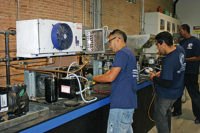
The International Facility Management Association (IFMA) has released “Temperature Wars: Savings vs. Comfort,” a new study that takes an in-depth look at the most common thermal complaints made by workers and the variety of ways facility professionals respond to them.
The study was conducted because for many years the association’s surveys of facility professionals, to learn the top office complaints, showed that temperatures being too hot or too cold were respondents’ most frequent complaint. It even surpassed high noise levels, limited space, and unpleasant odors.
This may be partly due to facility trends to adjust temperatures to decrease utility costs. “Recent IFMA research also shows that many facility professionals are adjusting the thermostat to higher settings in the summer and lower settings in the winter in an effort to cut energy consumption and costs,” the group said.
WHEN AND WHAT
The 2009 study identifies when most thermal complaints occur, what the complaints are specifically, and what is done to help workers feel more comfortable and able to concentrate on their jobs.The survey respondents again reported that the most common HVAC complaints they receive are that the temperature is too cold (94 percent) or too hot (91 percent). Indoor air quality complaints came in third (25 percent), followed by too drafty (21 percent) and too noisy (16 percent).
Building occupants adjust to thermal comfort issues in different ways. The most common means are by using personal fans (66 percent) or changing clothes (64 percent). Some workers also use personal heaters, which 60 percent of facility professionals report seeing. Many survey respondents say that personal heaters are not allowed, however, because they present a fire hazard. Other responses include using standalone air conditioning units, blankets, and even small wading pools under the desk.
“We have people with lap blankets and fingerless gloves on,” said one respondent. “Sad, isn’t it?”
To address occupants’ thermal complaints, 90 percent of facility professionals said they check the temperature in the area where complaints were made to see if it is within standards; 87 percent said they validate whether the HVAC system is working properly; and 75 percent adjust thermostats to provide for greater worker comfort.
Others said they encourage workers to wear layered clothing (35 percent) and temporarily move the worker to another area (4 percent). Still others report taking a vote of all occupants in a given control zone; asking people for a budget code to charge them for additional costs associated with running units more than agreed-upon parameters; or simply doing nothing.
“We sometimes say we’ll make an adjustment, but don’t,” said one respondent. “This actually seems to work.”
“Usually, a prompt response saying that we are handling it is key,” said another. “Then, we follow up in a couple of hours to find out if the ‘adjustments’ made an improvement. Often, we haven’t actually physically done anything to change the temperature.”
During summer months, survey respondents said they hear complaints that the temperature is both too hot (66 percent) and too cold (58 percent). However, 57 percent of facility professionals said their company does not relax the dress code during the summer to improve occupant comfort; 43 percent said their company does. Summer precooling, in which cool outdoor air is brought into a building at night, was reported by 47 percent of survey respondents.

CONTROL, EFFICIENCY
Most of those surveyed said temperatures at their facilities are centrally controlled and cannot be regulated by individual occupants (56 percent). Forty-two percent said temperatures in their buildings are zone controlled, allowing facility managers and sometimes occupants to adjust the thermostat; 2 percent reported that their buildings feature individual occupant or work station temperature control.It would seem that energy efficiency is of prime importance to these facility professionals. Seventy-seven percent said that they have updated or replaced an HVAC system or components; 73 percent said they have verified that their building automation system is working as designed; and 52 percent said they have installed more efficient light fixtures to reflect less heat. Others said that they have modified their ductwork (27 percent), installed new window shades (24 percent), and added window film to improve thermal properties (24 percent).
According to IFMA, the survey was drafted with the assistance of several HVAC experts, and taken during June and July 2009. It is based on the responses of 473 IFMA members, with a margin of error of approximately 5 percent.
For more information, visit www.ifma.org for a free copy of the report.
Publication date:08/31/2009





